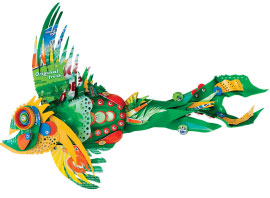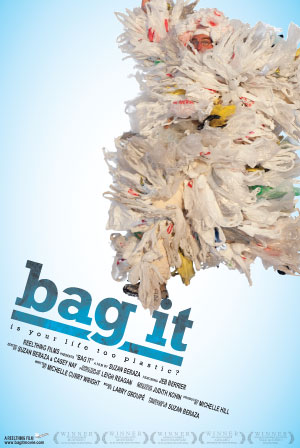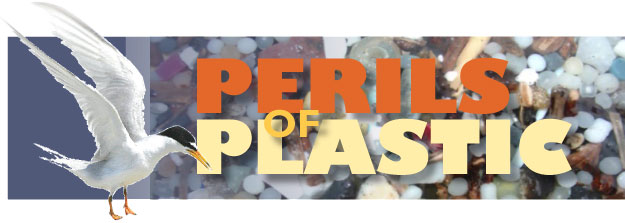 |
||||||||

When our nonprofit organization, Community Stepping Stones, won a Tampa Bay Estuary Program mini-grant 18 months ago, we embarked upon an adventure that has literally changed our lives. Our students participate in an after-school program for at-risk teens in Sulphur Springs. Located on the Hillsborough River, our campus is at the head waters of the estuary, so our idea was to collect river, bay and beach debris to use in a mosaic that spoke to our common waterway. We had no idea that our research would lead us to a face-to-face encounter with one of the most dangerous threats to our planet.
“When you throw something away, exactly where is away?”
You may have heard of the Great Pacific gyre — that floating garbage patch in the middle of the Pacific Ocean. But did you realize there are now five ocean gyres, each over 1,500 miles wide and one mile deep carrying 100+ million tons of plastic? The National Oceanic and Atmospheric Administration estimates that today every square kilometer of sea contains 46,000 pieces of plastic. In the past ten years the amount of plastic in our oceans has tripled, and it’s predicted to double again in the next ten years.
Where does the trash come from? Approximately 80% washes from the land down into our waterways. The rest blows off or is dumped by ships. Americans annually generate 10.5 million tons of plastic waste and recycle less than 25%. Eventually, about 50% of all plastics generated globally end up in the ocean.
The insidious nature of these whirlpools isn’t the big, chunky pieces of debris as much as it is the pulverized plastic particles which are entering the bottom of the food chain at an alarming rate. It takes up to 700 years for plastic to decompose, but when exposed to sun and waves, plastic breaks into minute particles and moves into solution.
Beginning in 2010, scientists at the Algalita Marine Research Foundation began investigating the suspended mass of plastic in the Pacific Ocean compared to the mass of zooplankton. One small study found six pounds of particulate plastic for every one pound of plankton. This incredible plastic displacement of tiny organisms means animals higher up the food chain are likely to ingest non-nutritious synthetic matter accidentally.
“Plankton is the foundation of the ocean’s food chain,” says Dr. Bridgette Froeschke, an oceanographer and microbiologist at the USF Florida Center for Community Design and Research. “When massive quantities of plastic are part of the ecosystem, filter feeders from whales to oysters are unable to discriminate their intake. The result is a break-down in their energy intake, which obviously affects their health.”

Far top: Participants in the Community Stepping Stones mural learned about plastic trash while doing beach clean-ups. Above: A bird skeleton found on Caladesi Island clearly shows that it had eaten plastic pieces before it died. Photo by Sigrid Tidmore
No ocean is free of plastic – and neither is Tampa Bay
The majority of Tampa Bay’s beautiful beaches are regularly cleaned and manicured. While this is great for tourism, it means we remain blissfully unaware of the vast quantities of refuse we are leaving behind in paradise. And despite our best efforts at hiding the trash, that pesky plastic is still finding its way into Tampa Bay and the Gulf of Mexico. Major sources locally include:
- Storm drain trash is, for the most part, the small stuff: straws, coffee stirrers, lighters, beverage bottles, caps, lids, plastic cutlery, food wrappers, the plastic casings of shot gun shells, 6-pack holders, cigarette butts, etc. For example, the City of St. Petersburg has more than 1,300 storm drains that each dump four to seven pounds of light plastic into surface waters with every downpour. That equates to 4.5 tons of plastic every time it rains – and that’s only St. Pete!
- Recreational trash, primarily from beach activities, contributes approximately 36.7% of litter found in the water, according to a University of Plymouth study. Local contributions
- include everything mentioned above, plus festival beads, diapers and syringes. Fishermen add bait containers, cleaner and oil bottles, fishing line, lures, nets, night sticks, rope, straps, crates, ice chests, plastic sheeting, light bulbs, and pallets.
- Dumping is where the really big stuff comes from — appliances, batteries, building materials, tires -- and more. You get the picture.
I asked Dr. Ernst Peebles from the USF College of Marine Science why, with all this trash entering Tampa Bay, we aren’t seeing our own gyres. “It’s the ocean currents that lift the trash into whirlpools. We don’t have that much circulation in the bay. Currents are relatively calm so things just become waterlogged and sink.”
Both Peebles and Froeschke voiced concern about what’s happening on a bacterial level to all that plastic invisible under bay waters. At first, it’s covered with bacteria and algae, and eventually barnacles, but underneath the new growth, the plastic continues to break down, eventually becoming part of the water column. “Bacteria are incredibly important in moving energy through the ecosystem,” says Peebles, “but they are the last to be considered.”
Another big problem with plastics is the fact that they break down over a period of centuries, not years, notes Chris Johnson, project manager for Keep Pinellas Beautiful. “And we’re seeing a lot more plastic — doctors are telling people to drink water, Gatorade and beverages like Propel which might be good for them but aren’t healthy for environment.”
Combining the rising costs of petroleum with consumer concerns about plastic, industry has created smaller bottles and smaller bottle caps. Several counties, including Hillsborough, are moving toward single-stream recycling which makes it easier for people to participate and recycled plastic becomes more valuable every time the cost of oil goes up.
Of course, not all plastic immediately breaks down and the larger pieces create a variety of problems:
- Biodiversity Displacement: Plastic is a magnet for bacteria and algae. Ocean buoys are being found with coral heads beginning to grow on them. This new habitat in the center of the deep ocean means that invading surface feeders begin to show up. When the deep ocean fish come up to feed at night, they find their food sources have been depleted. Shifts of a similar nature could be happening in our bay.
- Starvation by Plastic Blockage: The poster children of plastic ingestion are the sea turtles who consume bags, believing they are jellyfish. (Luckily, that’s only an occasional issue in Tampa Bay, according to Bill Sanders at Keep Pinellas Beautiful.) More disturbing are the hundreds of thousands of Pacific albatross chicks, dead because their unwitting parents fed them plastic shaped like krill or eggs — which is why so many bottle tops are found among their skeletal remains. Closer to home, Florida gulls and other scavengers consume plastic in their quest for food and suffer the same fate. Even the tiniest of fish are found to have plastic particles in their guts. Imagine having to swim with what are basically plastic floatation devices in your stomach that offer you no nutrition.
- Constricting Plastic: The internet is filled with photos of birds and animals strangled, deformed and starved by plastic wrapped around torsos and appendages. Virtually every boater has a story of untangling monofilament line and other plastic detritus from their propellers.
- Toxic Chemicals: As far back as 1998, researchers were concerned about BPA (Bisphenol A), a toxic endocrine disruptor that leaches from plastics. In fact, BPA is only one of several toxic chemicals released as large molecules when plastics like polyvinylchloride (PVC), polystyrene (styrofoam), polyethylene (bags) and the 80-plus other petrochemical plastics break down in water. Sand on beaches around the world (including Tampa Bay) now harbors vast quantities of grain-sized plastic pellets. In the Bahamas, there are beaches that are almost 100% plastic. A 2010 article in Science News describes a Japanese study of beach sand at 28 popular global sites, all of which reported toxicity from BPAs that were “orders of magnitude” greater than those sufficient to cause negative effects in animal and lab studies.

Colorful fish made from recycled plastic bottles and caps by artist Brenda Gregory.
So Where’s the “Better News?”
As the awareness of the global ocean crisis grows, local groups are taking action. Keep Pinellas Beautiful’s Recycling Regatta, to be held on April 20 this year, highlights the dangers of plastics in marine ecosystems. Keep Tampa Bay Beautiful scheduled a separate clean-up after the Gasparilla parade, largely to collect plastic water bottles and unwanted beads.
Another newly organized nonprofit is the Tampa Bay Green Consortium (www.tampabaygreenconsortium.org). TBGC was begun about a year ago by environmental veterans who wanted to offer a platform for coordinating diverse groups working on beach and waterway clean-ups. For instance, TBGC coordinates “Divers Against Debris” locally for the international organization, Project Aware. The trio also enlists volunteers from University of Tampa, USF and local dive clubs to survey underwater marine debris, collect data and orchestrate clean-ups.
“We try to remove serious environmental hazards from around heavily used piers, such as fishing line tangles, lost nets and non-biodegradable refuse,” says Dan Fisher, one of the group’s founders. “This restores habitat and safety to the area. Sometimes the group’s free services are met with resistance from skeptics, bureaucrats and reluctant pier managers who aren’t inclined to shut their piers for a couple hours once a year while divers do their work. Fisher is circumspect, “I guess it will take more public education before everyone appreciates that clearing out the trash now will improve the fishing in the long run.”
The data that Fisher and his volunteers collect about the refuse they remove is sent to Project Aware and the Ocean Conservancy, where it is compiled into a national annual report. Fisher sees a time when cleanups might be compensated for the marine waste they remove by selling it to the waste-to-energy industry as the cost of petroleum continues to rise.
In response to public concern, the plastics industry is moving towards more recyclable products. The nonprofit Biodegradable Plastics Institute (www.bpiworld.org) offers education, scientifically based standards and certification for new plastic products which are biodegradable in central composting facilities. Retailers as diverse as Whole Foods and Sears have moved to fully compostable plastic shopping bags. We can only hope that the ocean’s “central composting facility” is able to safely handle these new products.

Tampa Bay Sierra Club will present a FREE SCREENING of Bag It at 7 pm on April 22 at the Hillsborough Community College Performing Arts Building, 1304 E. 11th Ave., Ybor City.
For now, increased public awareness is our best hope that individuals will decide to modify their plastics addiction. Within the last two years, media attention is beginning to acknowledge the impending problems and Hollywood is beginning to crank out a series of “plastic alert” movies, like the award-winning Bag It, (visit www.Bagitmovie.com or attend the Tampa Bay Sierra Club screening on April 22.) National Geographic has a new site specifically for teachers on the “perils of plastic” to teach kids to be more careful about using plastics. And in California, like Florida, where tourism is a major industry, the state recently funded a study detailing the impact of plastic debris — including micro-plastics that may become part of the food chain.
As statistics-weary consumers, it’s easy to glaze over when we hear litanies of depressing facts about impending doom. Fortunately, artistic expressions have the power to gain our attention and make a massive concept become a personal mission. Visual and performing artists worldwide are taking up the cause of saving our oceans from certain synthetic doom. Just Google “Upcycled Art” or “Plastic Art” and you’ll be amazed.
Which brings me back to the Community Stepping Stones mural, “One Waterway One Tampa Bay.” As we sorted through the thousands of diverse plastic items we retrieved from local beaches, we realized we were witnesses to a system gone crazy. We were compelled to sound the alert. Today, the resulting 12-by-8-foot mural hangs in the VIP Suite level of the Tampa Bay Times Forum speaking its lesson to the thousands of people who will pass it this year.
All of us who worked on the project have had our lives changed. Our teens elected to make our campus a “water bottle free zone,” and they’re much more conscientious about getting the trash out. Me? I’m a bit nostalgic drinking water from my paper cup and remembering a time when there weren’t any plastics in paradise.
Sigrid Tidmore is an environmental writer and illustrator who also serves as the executive director of Community Stepping Stones (www.CommunitySteppingStones.org).
What you can do:
- Use your own water bottle, mug, utensils and bag at work.
- Say "No plastic straw please" when you dine out.
- Buy products that come with the least amount of plastic packaging.
- Pick up five pieces of plastic pollution every day.
- Volunteer to clean up litter. The Great American Clean-up is scheduled for April 27 in Hillsborough and March 9 through June 29 in Pinellas. Keep Manatee Beautiful will host a series of events throughout April and Pasco expects hundreds of volunteers to fan out across the county on April 20. Learn more about local events at www.kab.org.
- Spread the word that a little less plastic goes a long way. Use your own shopping bags, avoid plastic bottles and always recycle the plastic you must use!

